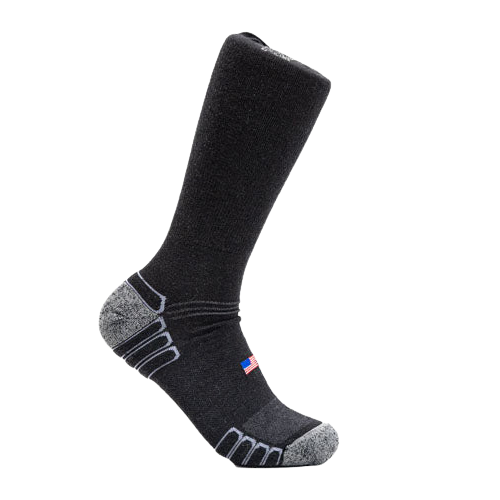We’ve all been there—you’re sure your boots are the right size, but they feel like flip-flops. I’ve tried wearing two pairs of socks to stop it from happening, but it’s annoying and quickly leads to sweaty feet.
Heel slippage causes you to unconsciously walk differently, rub your feet, and can make your feet ache as you’re gripping more with your toes.
After solving the problem through trial and error, I wanted to share how I’ve fixed heel slippage in my boots, so you don’t suffer as I did.
Here are a few proven methods for you to try.
#1 Wear the Right Work Socks

Before you look into other options, the first thing you should be doing is wearing proper socks.
Sports socks or thin everyday socks just won’t give your feet the grip you need—thick work socks with excellent heel and toe cushioning and grip can stop your heels from slipping.
The best option I’ve seen is the Camel City Mill range, and while both the Lightweight Wool Work Sock and its thicker Heavyweight Wool Work Sock alternative aren’t cheap, they’re incredibly robust but still comfortable.
Choose According to Climate

Unless it’s winter or you live in a colder climate, the Camel City Mill Lightweight Wool Work Sock will keep your feet warm enough. It's thermoregulated to keep your feet cool when it’s hot but plenty thick enough to keep your feet warm.
The Camel City Mill Heavyweight Wool Work Sock is perfect for winter or colder climates. High-density merino wool keeps your feet toasty and is heavily cushioned at the heel and toe, which makes it ideal for reducing or eliminating heel slippage.
Check for Gaps
Thick work socks should pad out your boots enough to reduce heel slippage, so once you’re wearing your work socks, test the toe and heel areas for gaps.
If you still notice a gap between your feet and your boot's toe or heel areas, you’ll have to add some additional support.
Before you think about fixing the toe or heel, though, there’s another option, which not only helps reduce heel slippage but also adds additional comfort and support for your feet.
#2 Insoles Add Height and Foot Support
As well as helping with comfort and support, insoles will make your boots feel snugger inside, which will help with any heel slippage.
The less space inside your boot, the better, and insoles also have the bonus of holding your feet in one place.
Fitting Your Insoles
Most boot insoles cover several sizes, so you shouldn’t have issues finding a pair that fits your boots.
You’ll need to move them around a little to make sure they’re in a perfect position. This will ensure your feet feel comfortable when your boots are on all day.
After positioning your insoles, put your boots on and walk around a little. If you can’t feel the edges of the insoles, and your feet feel well cushioned and supported, they’re in the right place.
Check for Gaps
Your insoles should reach from the back of your boots right up to the front, and you shouldn’t feel like you are trying to keep your feet on top of them.
If there are gaps at the front and back, the insole could slip, adding to your heel slippage. As long as the insole matches the existing sole, you’re going to notice an immediate improvement.
Match Your Insoles with Comfortable Work Socks

You should already notice less heel slippage as your feet are slightly higher in your boots, and your foot has less space to slip.
Ideally, you should also combine insoles with thick work socks—not only will your feet feel well cushioned, but the socks will pad your boot above your foot and at the heel and ankle.
With your foot well positioned on an insole and wrapped in thick work socks like the Camel City Mill Heavyweights, heel slippage should be a thing of the past.
#3 Heel Pads
If you’re struggling with too much space at the heel of your work boot, one of the best and most straightforward options is to use heel pads.
A heel pad will reduce the space between your heel and the rear of your boot and minimize slippage and rubbing by adding a lot of grip. They’re easy to fit, stay in position, and are often inexpensive.
Insert the Heel Pad
A heel pad is attached much like you’d put on a band-aid—you simply stick it to the inside of your boots against the heel.
Many heel pads can be used one on top of another, so if you need additional padding out, insert a heel pad, and then add more over the top as needed.
Ensure the Pad is Staying Put
I’ve found the best way to make sure the heel pad is sticking where you put it is to wear thick socks and then wear your boots around the home for a while.
Ensure your laces are tied tight, so the boot feels constricted and your heel presses against the pad, pushing it into place. Once it’s in place and secured, you can assess whether one pad will be enough.
As always, I’d recommend you wear the proper work socks with heel pads.
Heel pads are a great way to reduce slippage, and they’re such a simple design that little can go wrong—unless you’re wearing smooth dress socks that make it easier for your heel to slip.
#4 Toe Pads
If you’ve noticed little space between your heel and the rear of your boot, and you’re still suffering from heel slippage, a roomy toe box could be causing you issues.
Having too much free space at the front of your boots means every time you take a step, your foot will slide forwards, and when you lower your foot, the boot moves back into place.
Sometimes, that will cause your heel to slip as your foot isn’t getting any grip on the heel area. It’s a bit like wearing flip-flops with a heel on them—the flip is fine, but the flop is ruined.
You could go down the route of stuffing tissue paper into the toe of your boots, but that quickly becomes uncomfortable and annoying.
Find the Right Size
You’re always better off using toe pads that either come in multiple sizes or can be cut to size.
You want the toe pad to sit snugly against your toes but not to force them to scrunch up, which could cause severe pain over time.
If you need to cut the toe pads down, cut them in small increments to ensure you don’t trim too much off. Keep testing the pads inside your boots and walking around to try the comfort.
Secure the Pads in Place
Once you’re happy with the comfort, secure them inside your boots to stop any potential movement.
I’ve found hairspray works well for holding the toe pads in place.
It means you won’t have to glue the toe pads in (although a blob of glue is also acceptable), and the hairspray makes the pad sticky enough to stay in place.
Wear and Reassess
Once your toe pad is secure, wear them to work for a day or two and see how they feel. You may need to readjust or trim a little more off to make them completely comfortable.
If you’ve got the size right, you’ll no longer feel your boots sliding as you take a step, which means the chance of heel slippage should have vanished.
#5 Tongue Pads
If your boots still feel loose around the upper, especially the laces, try using tongue pads to fill out your boots.
As well as reducing slippage, tongue pads are great at preventing your feet from rubbing against your boot's upper.
Remove Your Laces
The easiest way to position the tongue pad correctly is to take out your laces, open up your boot, and pull out the tongue as far as it will go.
Once you’ve got access to as much of the underside of the tongue as possible, Don’t remove the sticky backing from the tongue pad yet, as you may need to reposition the pad later.
Test Out the Pad before Sticking It Down
Reposition the tongue and replace your laces. Once you’ve re-tied your boots, put them on and test how the tongue pad feels.
If it’s comfortable and you feel like it’s holding your foot down a little, then you can remove your laces, remove the backing, and stick the tongue pad in place permanently.
If it needs work, repeat step one until you’re happy, and then stick the pad in place.
Lace up and Head Out
Once your tongue pads are stuck in position, you’ll be able to move around freely and shouldn’t see a repeat of your heel slippage. The tongue pads gently cushion your foot from above, pushing it down and stopping your foot from sliding around.
Combined with a pair of thick work socks, you should see an instant decrease in foot slippage and the benefit of even more comfortable work boots.
Slippage Is a Thing Of The Past

While heel slippage might start as an inconvenience, it can quickly become serious discomfort or worse, especially if you’re wearing your work boots all day.
Thankfully, stopping heel slippage is easy when you use the right tools.
Using insoles alongside my Camel City Mill Wool Work Sock worked perfectly for my heel slippage, but it could be something as simple as a heel grip that fixes it for you.






